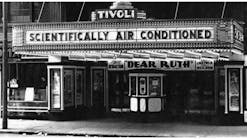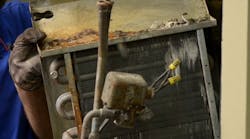It is inevitable: Over time, your facility’s HVAC will break down or require an upgrade. When that time comes, you must decide whether to refurbish, retrofit, or replace equipment.
In the case of fan-coil systems, each option has pros and cons. In this article, we will examine the refurbishment, retrofit, and replacement of modular high-rise units, or vertical-stack fan coils, which are designed to fit a wide range of applications and are, in general, among the most commonly utilized.
Key Considerations
Key questions to consider when making the decision to refurbish, retrofit, or replace include:
- What is the cost of repairing equipment vs. that of replacing it? While the cost of repairing equipment might be minimal, the long-term savings resulting from installing new, more efficient equipment can be significant.
- Is the HVAC upgrade part of a larger building revamp? If the HVAC system is not part of a larger update, a replacement can be an easy, cost-effective solution.
- Is there new technology that can provide improved indoor-air quality (IAQ) and comfort? Modern HVAC companies now can provide the latest in air-quality and comfort enhancements without having to shut down entire floors.
Making the decision to refurbish, retrofit, or replace HVAC equipment comes down to the practicality of the install and whether the install is cost-effective and meets industry standards for safety.
Refurbishment and Retrofit
With refurbishment, just a few components can be replaced to upgrade a unit and its performance, resulting in significant cost savings over replacement. Historically, this has been the most popular method, seen as cost-effective and practical, allowing building owners to get the most life out of an existing fan-coil unit. While cost-effective, this method often is only a short-term solution to a long-term problem. Refurbishment can be more time-intensive than retrofit and/or replacement jobs, sometimes taking up to one to two days to complete. Furthermore, in a refurbishment, coils often are chemically cleaned, which generally extends a fan-coil unit’s serviceable life by only five to seven years, at the end of which the issues will need to be addressed again. Simply cleaning coils neither addresses the possible buildup of scale within the tubes nor remedies the degradation of the fin-to-tube connection that occurs over time. Installation of a new unit will provide roughly 20 to 25 years of serviceable life.
In a retrofit, a fan-coil unit is recommissioned and the electronically commutated motor (ECM) is retrofitted to increase the efficiency and overall life of the unit. This is a viable solution when replacement is not an option.
Replacement
Though overhauling older buildings requires significant investment of time, resources, and money and often poses many challenges concerning the replacement and adaptation of existing mechanical systems, it has spurred development of easy replacement solutions that allow owners to reap the benefits of new equipment without the additional costs associated with construction repair.
Here is what to look for when replacing fan coils:
- Modern design, minimal disruption. Because time and money are critical considerations for most projects, look for a unit that can slide into the existing cabinet and allow you to utilize the current electrical connections.
- Ease of installation. Modern fan coils have been engineered to ease the installation process. Replacements can be accomplished with one installer and one HVAC startup/control technician. These replacements can be completed on a room-by-room basis without impacting neighboring spaces, eliminating the need to shut down entire floors or risers. While a full replacement can take days, this three-step installation process can be completed in less than four hours:
- Remove the original components from the fan-coil unit. Trim the cabinet and drywall as needed.
- Once the space is cleared, slide in the new HVAC system and connect it to the existing infrastructure.
- Reconnect the power wiring and control wiring, install the thermostat, and proceed to startup and test operations.
- This process uses existing material, which minimizes waste and disturbances to surrounding walls and finishes, helping to get rooms up and running again quickly.
- Simplified service. Not only do modern fan-coil units slide into existing spaces, they can be accessed easily for regular servicing. Depending on their usage, some fan coils need their filters changed once a month or once every three months, so installing a unit that is accessible without causing disruption is critical. Additionally, new modern fan coils are designed so all major components, including the motor, can be removed in less than 15 min.
- Compatible and customizable configurations. Make sure you look for products that are compatible with your existing units with respect to size and performance. Selection of a unit that can be customized to an application eliminates the need for extensive reconstruction work, saving time and money.
- Quality and comfort. Studies have shown HVAC is a critical factor in maintaining IAQ. Well-designed fan-coil solutions can help regulate temperature and humidity, in addition to minimizing outdoor-air amounts, economically and efficiently. Other features of modern fan coils are closed-cell insulation and an ECM, which can help to enhance the comfort of tenants and the energy efficiency of buildings.
Conclusion
As HVAC equipment ages, efficiency decreases, costs increase, and occupant comfort is sacrificed. Replacement often is seen as an expensive and disruptive strategy. However, with new technology and units that can be installed easily, there no longer is concern about lengthy and costly construction. And in the long run, replacement can offer the greatest return, providing a highly efficient system for a longer period of time.
When replacement is not an option, building owners can utilize targeted repair, refurbishment, and/or the upgrading of existing equipment to bring it in line with current performance standards and regulations. All are viable solutions; building owners must weigh the pros and cons of each and determine where their priorities lie. If HVAC maintenance is in the short-term building strategy, refurbishment offers a lower first-cost solution, while replacement enables serviceability for longer building life.
Jeffrey D. Tucker, CEM, CMVP, is director of retrofit solutions for The Climate Control Group Inc., a manufacturing, marketing, and engineering company.
Did you find this article useful? Send comments and suggestions to Executive Editor Scott Arnold at [email protected].











